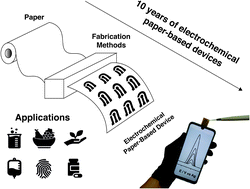Electrochemical paper-based analytical devices: ten years of development
Abstract
The last decade saw the development of electrochemical paper-based analytical devices (ePADs). While sharing the characteristics of microfluidic paper-based analytical devices (μPADs) that use colourimetric detection, ePADs show enhanced limits of detection and selectivity, avoid the bias of human eye observation without any considerable increase in the device cost, and maintain the capacity for miniaturisation and in-field application. Over this period, different ingenious approaches were used to fabricate ePADs for many analytical problems such as in clinical and forensic applications. Hence, we review the fabrication procedures of these ePADs, from the initial report to the steps used to pattern the physical/chemical boundaries (non-conductive patterns) and conductive tracks (electrodes) on a paper substrate. Selected literature is discussed according to the fabrication procedures, electrochemical detection techniques, and applications. We also discuss other interesting approaches using conductive tracks on PADs for non-electrochemical transduction, i.e., as an electrical tool to assist in sample preparation or preconcentration steps, as well as some applications in the energy-related field. At the end, an overview and trends in the fabrication, application, and commercialisation status of ePADs are provided.

- This article is part of the themed collection: Celebrating Latin American Talent in Chemistry


 Please wait while we load your content...
Please wait while we load your content...